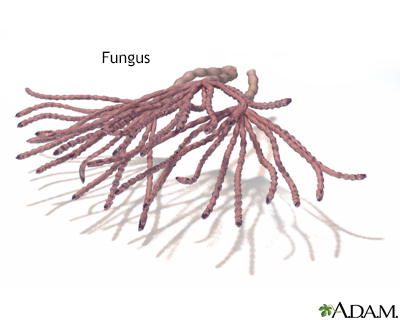Candida infection of the skin
Definition
Candida infection of the skin is a yeast infection of the skin. The medical name of the condition is cutaneous candidiasis.
Alternative Names
Skin infection - fungal; Fungal infection - skin; Skin infection - yeast; Yeast infection - skin; Intertriginous candidiasis; Cutaneous candidiasis
Causes
The body normally hosts a variety of germs, including bacteria and fungi. Some of these are useful to the body, some produce no harm or benefit, and some can cause harmful infections.
Some fungal infections are caused by fungi that often live on the hair, nails, and outer skin layers. They include yeast-like fungi such as candida. Sometimes, these yeast penetrate beneath the surface of the skin and cause infection.
In cutaneous candidiasis, the skin is infected with candida fungi. This type of infection is fairly common. It can involve almost any skin on the body, but most often it occurs in warm, moist, creased areas such as the armpits and groin. The fungus that most often causes cutaneous candidiasis is Candida albicans.
Candida is the most common cause of diaper rash in infants. The fungi take advantage of the warm, moist conditions inside the diaper. Candida infection is also particularly common in people with diabetes and in those who are obese. Antibiotics, steroid therapy, and chemotherapy increase the risk of cutaneous candidiasis. Candida can also cause infections of the nails, edges of the nails, and corners of the mouth.
Oral thrush, a form of candida infection of the moist lining of the mouth, usually occurs when people take antibiotics. It may also be a sign of an HIV infection or other weakened immune system disorders when it occurs in adults. Individuals with candida infections are not usually contagious, though in some settings people with weakened immune systems may catch the infection.
Candida is also the most frequent cause of vaginal yeast infections. These infections are common and often occur with antibiotic use.
Symptoms
Candida infection of the skin can cause intense itching.
Symptoms also include:
- Red, growing skin rash
- Rash on the skin folds, genitals, middle of the body, buttocks, under the breasts, and other areas of skin
- Infection of the hair follicles that may look like pimples
Exams and Tests
Your health care provider can usually diagnose this condition by looking at your skin. Your provider may gently scrape off a sample of skin for testing.
Older children and adults with a yeast skin infection should be tested for diabetes. High sugar levels, seen in people with diabetes, act as food for the yeast fungus and help it grow.
Treatment
Good general health and hygiene are very important for treating candida infections of the skin. Keeping the skin dry and exposed to air is helpful. Drying (absorbent) powders may help prevent fungal infections.
Losing weight may help eliminate the problem if you are overweight.
Proper blood sugar control may also be helpful to those with diabetes.
Antifungal skin creams, ointments, or powders may be used to treat a yeast infection of the skin, mouth, or vagina. You may need to take antifungal medicine by mouth for severe candida infections in the mouth, throat, or vagina.
Outlook (Prognosis)
Cutaneous candidiasis often goes away with treatment, especially if the underlying cause is corrected. Repeat infections are common.
Possible Complications
These complications may occur:
- Infection of the nails may cause the nails to become oddly shaped and may cause an infection around the nail.
- Candida skin infections may return.
- Widespread candidiasis may occur in people with weakened immune systems.
When to Contact a Medical Professional
Call your provider if you develop symptoms of cutaneous candidiasis.
Gallery



References
Centers for Disease Control and Prevention website. Fungal diseases: candidiasis. www.cdc.gov/fungal/diseases/candidiasis/index.html. Updated October 30, 2020. Accessed February 28, 2021.
James WD, Elston DM, Treat JR, Rosenbach MA, Neuhaus IM. Diseases resulting from fungi and yeasts. In: James WD, Elston DM, Treat JR, Rosenbach MA, Neuhaus IM, eds. Andrews' Diseases of the Skin: Clinical Dermatology. 13th ed. Philadelphia, PA: Elsevier; 2020:chap 15.
Lionakis MS, Edwards JE. Candida species. In: Bennett JE, Dolin R, Blaser MJ, eds. Mandell, Douglas, and Bennett's Principles and Practice of Infectious Diseases. 9th ed. Philadelphia, PA: Elsevier; 2020:chap 256.